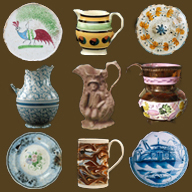Glossary
A B C D E F G H I J K L M N O P Q R S T U V W X Y Z
A
B
Baker
Bakers are listed on almost all of the Staffordshire potters’ price
fixing lists following the flat ware. These vessels are generally oval
or oblong hexagonal and thus had to be pressed rather than thrown on a
wheel. They almost never have a footring and the rims are flat. Most are
undecorated, but they do occur with shell edging and painted patterns
as well as printed patterns. These vessels often are listed as bowls in
archaeological reports.
C
Chafing dish
A pedestaled vessel that holds coals used to warm food.
Chamber
pot
A sturdy, handled vessel with a flat, flared rim, used as a portable toilet.
Charger
A large flat dish with a diameter greater than ten inches, often made
for decorative use.
China
Glaze
China
glaze is defined as a combination of ware and decoration. It is
refined white earthenware manufactured in imitation of Chinese
porcelain, i.e. the glaze is tinted blue for the correct look,
the patterns are in a Chinese style, and the footrings on plates
are often undercut in a Chinese style. Shell-edged plates with
Chinese-style painted centers should be called China glaze; these
date from c.1775 to c. 1810.
Cobalt
A blue pigment of cobalt oxide and alumina used for underglaze decoration.
Coggle
An engraved wheel which is rolled over an unfired vessel to create notching
or other patterns.
Colander
A pan-shaped vessel with perforations on the bottom or sides for drainage.
Combing
Dragging pointed instruments through wet slip bands in order to create
a zigzag pattern.
Crazing
Cracking in the glaze that occurs when the glaze shrinks more than the
body after firing.
Cup
A small drinking vessel with or without a handle.
D
Dish
A large, flat serving vessel that can be shallow or somewhat deep.
Drug
Jar
A cylindrical vessel for storing drugs, cosmetics, or condiments. Also
called a galley pot or apothecary jar.
E
Earthenware
Ceramics containing a low proportion of silica and fired at low temperatures
(900 – 1150o F). Earthenwares are porous and must be sealed
with a glaze to hold liquids.
Embossed
Enamel
painted
Enamel painting is painting on top of the glaze. Pottery workers who
did this type of painting were Enamellers. Individuals who painted
underglaze patterns were called blue painters, regardless of the
colors they used.
Engine
Turned
A decorative technique where relief designs are cut into vessels while
in the leather hard stage by turning them on a lathe.
Engobe
A coating of slip applied to the surface of a vessel for decorative purposes
or to cover up an imperfection in the vessel's surface.
F
Fabric
The clay body or paste of a ceramic.
Flat Ware
Shallow vessels such as dishes, platters, chargers, plates, and saucers.
Flux
A substance added to ceramics and glazes which lowers their melting
point. Often used to fuse overglaze pigments to the glaze.
Fritting
Fritting is a process of melting the ingredients used
in a glaze into a glass that is then broken up and ground into
a fine powder that can be mixed in water for the dipping of bisque
fired wares. When the wares are dipped in the glaze, they absorb
some of the water that carries the glaze materials and in that
process the fritted glaze is deposited on the vessel's surface.
Fritting is essential for alkaline glazes that contain soda, potash,
boracic acid, as a part of the glaze because they are soluble
in water and would be diluted by the water used to carry the glaze
to the bisque fired wares.
G
Glaze
A thin coating applied to ceramic bodies for the purpose of making them
impervious to liquid absorption and for decorative purposes.
H
Hard-Paste
Referring to porcelains which are composed of feldspathic clay fired at
a high enough temperature to vitrify them. Chinese porcelains are true
hard-paste porcelains, while many 18th century Continental and English porcelains are considered to be soft-paste.
Hollow
Ware
Container forms such as tea and coffee pots, bowls, pans, cups, jugs,
jars, tankards, and pitchers.
I
Incising
Decorative technique in which lines are scratched, either mechanically
or by hand, into the wet body of a ceramic.
J
Jug
A bulbous, handled vessel with a cylindrical neck, with or without a spout,
used for drinking or serving liquids.
K
Kaolin
A fine-grained white clay that is a major component of porcelain.
Kiln
The oven in which ceramics are fired.
L
Lead Glaze
A standard glaze for earthenwares containing silica and alumina and a
lead oxide flux.
Leather
Hard
The stage in which unfired pottery is no longer in a plastic or wet state,
and can be handled without distortion to the form.
M
Marbling
A decorative technique in which a vessel covered with bands of wet slip
is sharply twisted, causing the slip to run across the piece and form
abstract patterns.
Marly
The marly is the flat border area of a plate, twiffler or muffin between
the rim and where the plate angles down into the flat area. It is the
area most commonly used for painted decoration. Saucers, bowls and other
vessels do not have a marly.
Milk
Pan
A large pan with sloping sides used to cool dairy products, as a wash
basin, or for cooking.
Muffin
Plate whose diameter ranges between four to seven inches.
Muffin plates sometimes get misclassified as saucers. Small saucer
size plates with a marly are muffin plates.
Mug
A straight-sided, handled drinking vessel, taller than it is wide.
N
Nappie
Nappies are the same as baker but they have an everted curved rim. They
are usually less common than bakers and, like bakers, are often listed
as bowls in archeological reports. Like bakers, they almost never have
footrings and are pressed rather than thrown.
Neoclassical
Characteristic of a style in decorative art and architecture prevalent
during the mid 18th to the 19th century that drew inspiration from Western
classical culture and art.
O
Overglaze
Enameling
Painted colors applied on top of the glaze and lightly refired at a low
temperature.
Oxidizing
Referring to the oxygen atmosphere inside a kiln during firing, which
causes color changes due to chemical reactions in the glaze or body. For
example, fine stoneware fired in an oxygen atmosphere can be turned brick
red, while the same clay fired in a reducing atmosphere can be colored
black.
P
Paste
The clays and other materials that constitute the body of a vessel (see
fabric).
Plate
A flat, round eating or serving vessel that is less than ten inches in
diameter, smaller than a charger.
Pitcher
A bulbous, handled vessel with a pouring lip.<
Pipkin
An small, rod-handled earthenware cooking vessel, that often has three
legs.
Porcelain
Ceramics with a vitrified body originally made from petuntse (feldspathic rock) and kaolin fired at a very high temperature.
Porringer
A small, hemispherical, somewhat shallow vessel with one or two handles,
used for eating foods like soup or porridge.
Posset Pot
A large, bulbous drinking vessel, often with multiple handles, that is
also referred to as as "loving cup".
Powdered
Ground
A decorative technique, usually found on tin-glazed wares, that is produced
by sifting or sprinkling a powdered oxide over areas of a vessel. This
techniques is also known as "Dusting."
Press
Molded
A vessel or vessel element (such as a handle or spout) which was formed
by pushing wet clay over a mold.
Puzzle Jug
A drinking vessel with a hollow handle and at least three spouts.
A hole in the handle, and all but one of the spouts, had to be sealed
with fingers to avoid spilling the liquids while drinking.
Q
R
Rococo
Decorative style that emulate seashells. Rococo shelled vessels have asymmetrical,
undulating borders.
S
Salt-Glazed
A high temperature glaze which is formed by the addition of common salt
into the kiln when it is at the highest temperature. The vaporized
sodium combines with the silica on the surface of the vessel to create
a glossy, hard glaze. Salt glazes are characterized by a pitted
"orange peel" texture and are only used on stonewares.
Scratch Blue
A decorative technique used on English white salt-glazed stoneware
and pearlware. Before firing, decorative motifs were incised into
the clay and filled with cobalt blue oxide. The excess paint was
wiped away leaving only the blue filled lines. Referred to as
Scratch Brown when a brown oxide is used.
Slip
A liquid mixture of clay and water applied to vessel surfaces.
Slip Casting
A manufacturing technique in which liquid clay is poured into a vessel
mold and then allowed to dry to the leather hard stage. After opening
the mold, the vessel form inside can be trimmed, decorated, and fired.
Slip Decoration
Designs created by applying different colored slips to a vessel.
Soft-Paste
Porcelain paste composed of white clay mixed with various additives, such
as ground soapstone or frit (ground glass that is partially vitrified).
Eighteenth century English and Continental porcelains are often soft-paste,
while Chinese porcelains are hard-paste, and fired at a higher temperature.
Sprig-Molding
A decorative technique in which molded clay ornaments are attached to
a vessel before firing.
Staffordshire
A pottery-producing district in England since the early 1700s.
Stamping
A decorative technique in which a die or other tool is used to impress
designs or manufacturer's marks onto unfired clay.
Stoneware
Non-porous ceramic paste in which there is enough silica content that
when fired at a high temperature (ca. 1200o C), partial vitrification
occurs.
T
Tableware
Ceramic vessels such as plates, cups, saucers, dishes, tureens, pitchers,
or other pieces which are designed for serving or consuming food and drink
at the table.
Tankard
A large, cylindrical or bulbous drinking vessel with a handle, that is
taller than a mug.
Tea
Ware
Ceramic vessels that are used specifically which is for serving tea, including
teapots, teacups, saucers, sugar bowls, slop dishes, cream jugs, and tea
caddies.
Throwing
The manufacture of pottery by hand on a wheel.
Tin-Glazed
A glaze to which tin oxide has been added to make it opaque and white.
Trailing
A decoration technique in which tubes are used to dribble lines or dots
of colored slip on a vessel surface.
Transfer
Print
A decorative technique developed in the 18th century, in which an engraved
copper plate is coated with ink and the pattern is then transfered by
a glue bat to the vessel being printed. An improved method used thin sheets
of tissue paper to transfer the design.
Twiffler
In the Staffordshire potters’ price fixing lists from 1795 on
to 1846, twifflers are listed as eight inch plates. Supper plates are
nine inches and dinner plates are ten inches in diameter. However, through
time, the sizes of these vessels were increased above their stated size.
Plates ranging from four inches to seven inches were listed as muffins.
Tyg
A two-handled mug.
U
Underglaze
Decoration
Painted decoration on leather hard or bisque vessel surfaces added before
applying a glaze.
V
Vitrify
A process whereby the silicate fragments in a clay body fuse together
when fired at high temperatures. Generally, the higher the firing temperature,
the greater the degree of vitrification.
W
X
Y
Z |



